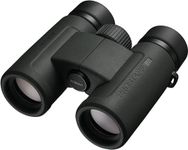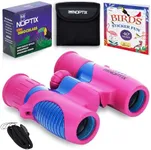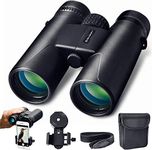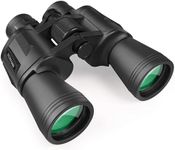Buying Guide for the Best Quality Binoculars
Choosing the right binoculars can greatly enhance your outdoor experiences, whether you're bird watching, hiking, or attending a sports event. The key to finding the best binoculars for you is understanding the various specifications and how they align with your specific needs. Here are the main specs to consider when selecting quality binoculars.MagnificationMagnification indicates how many times closer an object will appear compared to the naked eye. For example, 8x magnification means the object will appear eight times closer. Higher magnification (10x or more) is great for detailed viewing but can be harder to stabilize and may require a tripod. Lower magnification (7x or 8x) offers a wider field of view and is easier to handle, making it ideal for activities like bird watching or general use.
Objective Lens DiameterThe objective lens diameter, measured in millimeters, determines how much light the binoculars can gather. Larger diameters (e.g., 42mm or 50mm) provide brighter images and perform better in low-light conditions but can be bulkier and heavier. Smaller diameters (e.g., 25mm or 30mm) are more compact and lightweight, suitable for daytime use and portability. Choose based on your need for brightness versus portability.
Field of ViewField of view (FOV) is the width of the area visible through the binoculars, usually measured in feet at 1,000 yards. A wider FOV allows you to see more of the scene, which is beneficial for tracking moving objects like birds or wildlife. Narrower FOV provides more detail but less peripheral vision. Consider a wider FOV for dynamic activities and a narrower FOV for detailed observation.
Lens CoatingLens coating enhances light transmission, reduces glare, and improves image clarity. Coatings can be single-layer, multi-layer, or fully multi-coated. Fully multi-coated lenses offer the best performance with the brightest and clearest images. If you need high-quality viewing, especially in varying light conditions, opt for fully multi-coated lenses.
Prism TypeBinoculars use either roof prisms or porro prisms. Roof prisms are more compact and durable, making them suitable for outdoor activities. Porro prisms generally offer better depth perception and a wider field of view but are bulkier. Choose roof prisms for portability and rugged use, and porro prisms for image quality and depth.
Eye ReliefEye relief is the distance from the eyepiece to your eye while still seeing the full field of view. Longer eye relief (15mm or more) is crucial for eyeglass wearers to see the entire image without vignetting. If you wear glasses, look for binoculars with longer eye relief to ensure comfortable viewing.
Waterproof and FogproofWaterproof and fogproof features protect binoculars from moisture and internal fogging, ensuring clear viewing in various weather conditions. These features are essential for outdoor activities like hiking, bird watching, or marine use. If you plan to use binoculars in wet or humid environments, prioritize models with these protections.
Weight and SizeThe weight and size of binoculars affect portability and ease of use. Heavier binoculars can be tiring to hold for extended periods, while lighter models are easier to carry and handle. Consider how long you'll be using the binoculars and whether you'll be carrying them over long distances. Choose a balance between performance and comfort based on your activity.






















